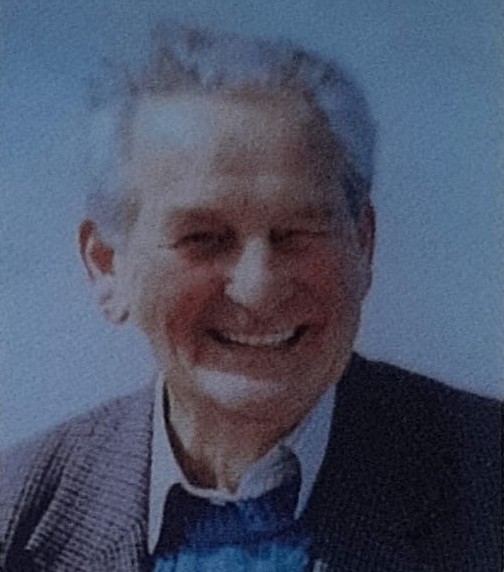William Connell of Newbridge, Co. Kildare [Gen-040]
When the research commenced, very little was known about William O'Connell prior to his arrival in Newbridge.
According to family tradition he had been in the British Army and had fought in the Crimean War (1854 - 1856). While in the Crimea, William rescued his commanding officer who had been wounded and they became life-long friends. The officer's name was Wolsey and he was said to have come from Co. Louth.
The Birth Certificate of William's youngest daughter, Anne Elizabeth, revealed. that her father was a Colour Sergeant in the Dublin Militia. Militia units did not usually serve abroad, however, so if he had served in the Crimea, he must have been in a regular Army unit before joining the Dublin Militia. It was known in the family that William's daughter Mary had been born in Aldershott, England and her date of birth was also known. An enquiry to the Register-General of Births in England produced a copy of her Birth Certificate and it provided the information that she was born in South Camp, Aldershott, and that her father was a Sergeant in the First Battalion, 17th Regiment of Foot. Research in the regimental records at the Public Record Office, Kew, England, produced valuable information. (See later for photostats of the regimental records and a typed summary of the information therein relating to William O'Connell (or Connell)).
The most valuable information in the regimental records was the place of birth of William O'Connell - Windgap, Co. Kilkenny. This resulted in the tracing of his parents.
It will be noted that the Army records state that William was 18 years of age when he enlisted on the 18th January, 1849. In fact he was 20½ years of age then. Possibly he was asked if he were 18 years of age (the normal minimum age for enlisting) and answered "Yes". It can be taken that the Baptismal Record is correct and that he was born in 1828. The age recorded on his Death Certificate seems to be his "Army" age.
None of the medals awarded to William O'Connell seem to have been for valour. However, the family tradition that he saved the life of an officer named Wolsey probably has some basis in fact. It is interesting to note that there is an entry on Page 981 of Chamber's Biographical Dictionary (1938 Edition), published by T. and A. Constable, Edinburgh, regarding Garnet Joseph Wolseley (pronounced Woolz-ley) who had a rather colourful career, ending as Commander-in-Chief of the British Army. and a Viscount.
He [Wolseley] was born at Golden Bridge House, Co. Dublin on 4th June, 1833. (William O'Connell would have been five years his senior). He entered the Army in 1852. He served in the Burmese War of 1852 - 1853, and was dangerously wounded. In the Crimea he lost the use of one eye (this fits in with the family tradition of William rescuing his officer) and received the Cross of the Legion of Honour. After service in India and China he went to Canada (then known as North America) in 1861. (William 0'Connell served nearly three years in North America.) General Wolseley's autobiography "Story of a Soldier's Life" (1903) or his biography by
Maurice and Arthur (1934) may throw more light on the matter. The Field Marshal, as he then was, died in 1913.
Editor's addition, 2025:
As an exception to the general no AI rule of this site (see Cookie policy) a query of perplexity.ai was conducted in an attempt to verify this story.
According to the family tradition, Colonel Wolsey (as he was always referred to by the family) and William O'Connell remained friends all their lives: he helped William in business and obtained for him the agencies of several breweries. (This would seem to indicate that he felt under some obligation to him as in those days there was an immense gap between an ex-sergeant and an officer of any rank.)
In this connection it is interesting to note that an advertisement was published in the "Freemen's Journal" on 1st March, 1819, for Castlebellingham Ale, manufactured by Woolsey & Cairnes, Castlebellingham, Co. Louth.
William O'Connell (Connell on his Death Certificate) died on 2nd October, 1875 in Newbridge after being ill for two weeks. As mentioned earlier administration of his Will was granted to a creditor in 1884.
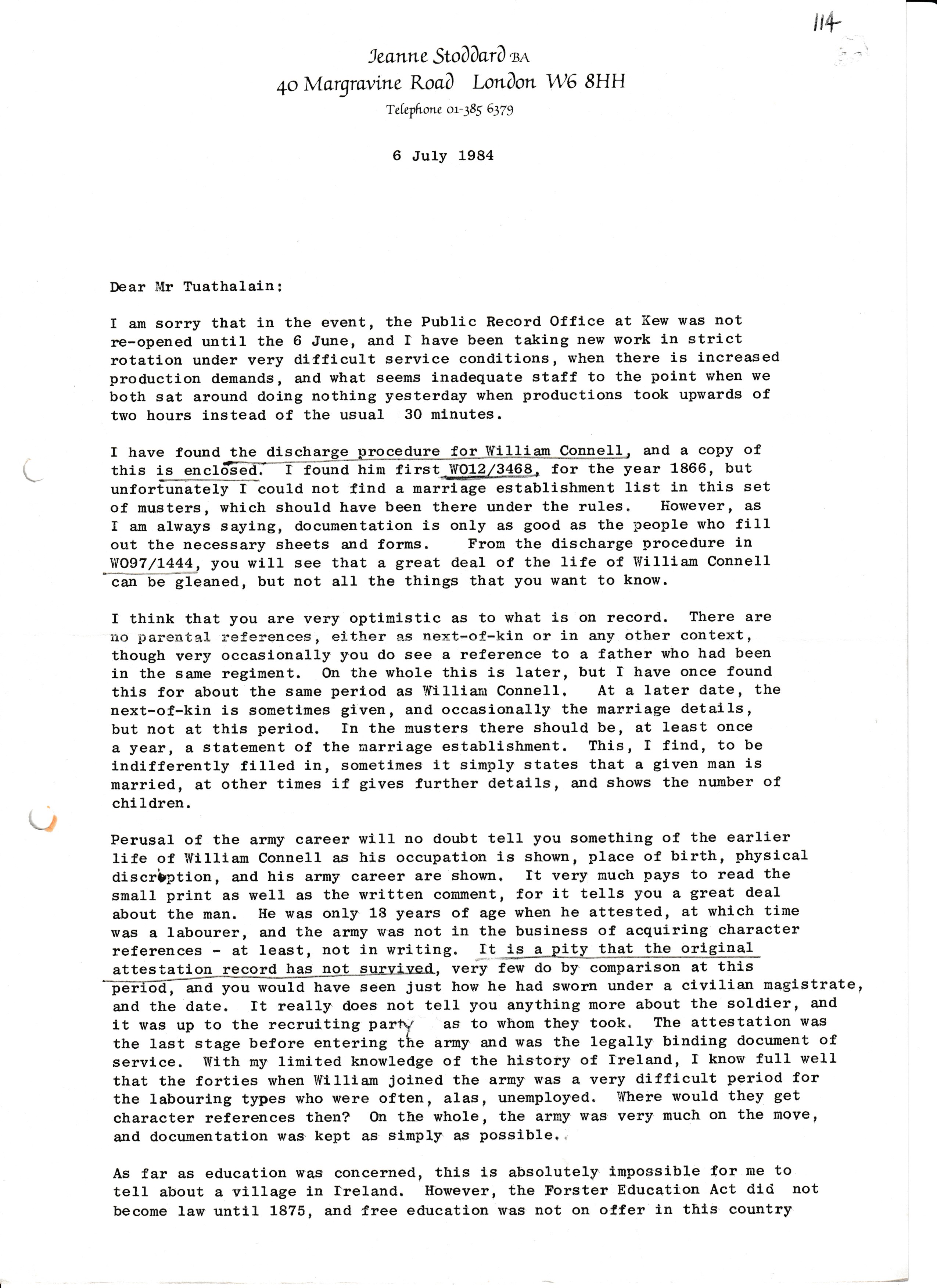
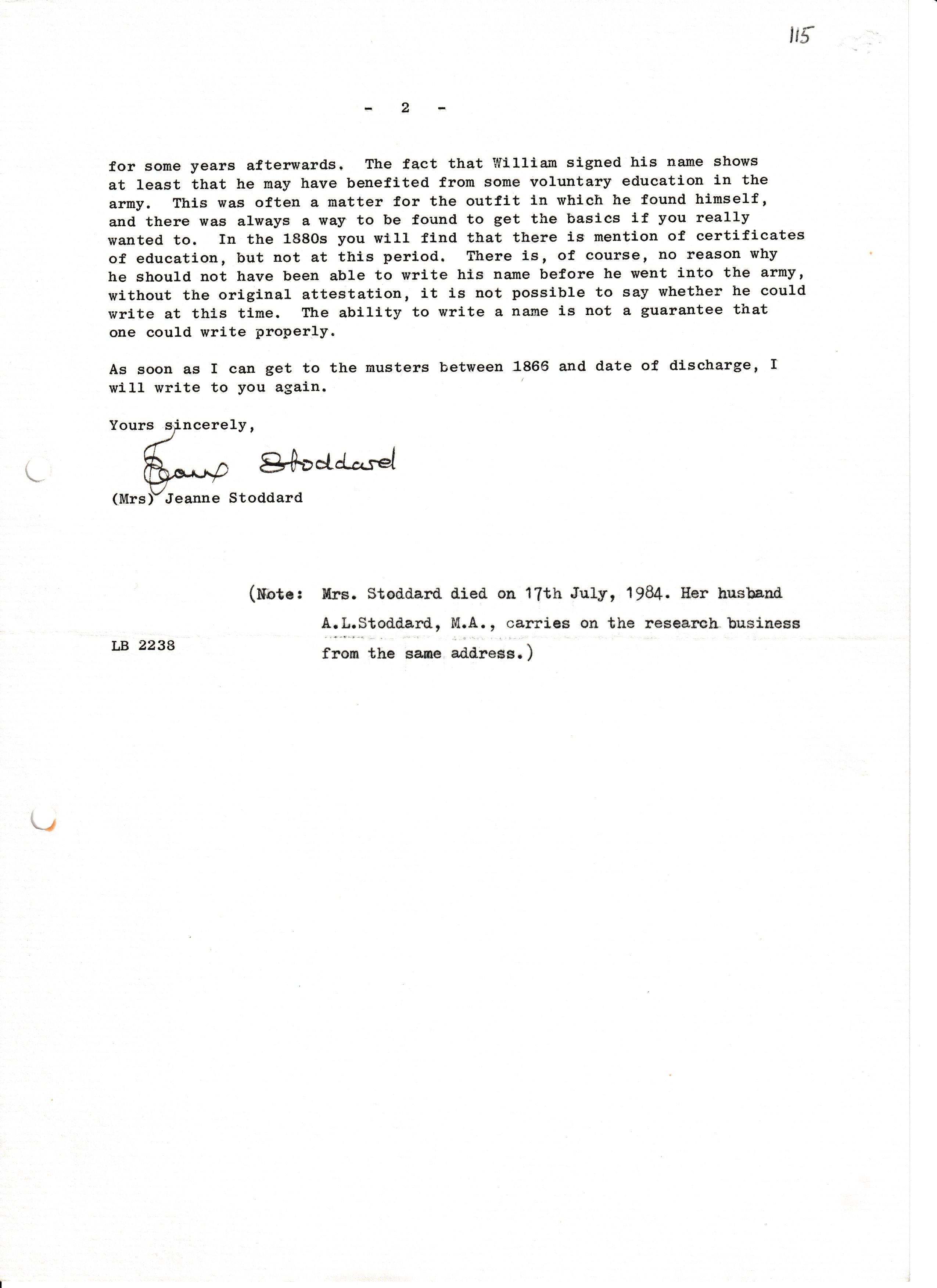
Editor's addition, 2025
The transcribed text of the original is provided here to make it better findable in an internet search.
Jeanne Stoddard A
40 Margravine Road London W6 8HH
Telephone 01-385 6379
6 July 1984
Dear Mr Tuathalain:
I am sorry that in the event, the Public Record Office at Kew was not re-opened until the 6 June, and I have been taking new work in strict rotation under very difficult service conditions, when there is increased production demands, and what seems inadequate staff to the point when we both sat around doing nothing yesterday when productions took upwards of two hours instead of the usual 30 minutes.
I have found the discharge procedure for William Connell, and a copy of this is enclosed. I found him first W012/3468, for the year 1866, but unfortunately I could not find a marriage establishment list in this set of musters, which should have been there under the rules. However, as I am always saying, documentation is only as good as the people who fill out the necessary sheets and forms. From the discharge procedure in W097/1444 you will see that a great deal of the life of William Connell can be gleaned but not all the things that you want to know.
I think that you are very optimistic as to what is on record. There are no parental references, either as next-of-kin or in any other context, though very occasionally you do see a reference to a father who had been in the same regiment. On the whole this is later, but I have once found this for about the same period as William Connell, At a later date, the next-of-kin is sometimes given, and occasionally the marriage details, but not at this period. In the musters there should be, at least once a year, a statement of the marriage establishment. This, I find, to be indifferently filled in, sometimes it simply states that a given man is married, at other times if gives further details, and shows the number of children.
Perusal of the army career will no doubt tell you something of the earlier life of William Connell as his occupation is shown, place of birth, physical discription, and his army career are shown. It very much pays to read the small print as well as the written comment, for it tells you a great deal about the man. He was only 18 years of age when he attested, at which time was a labourer, and the army was not in the business of acquiring character references - at least, not in writing. It is a pity that the original attestation record has not survived, very few do by comparison at this period, and you would have seen just how he had sworn under a civilian magistrate, and the date. It really does not tell you anything more about the soldier, and it was up to the recruiting party as to whom they took. The attestation was the last stage before entering the army and was the legally binding document of service. With my limited knowledge of the history of Ireland, I know full well that the forties when William joined the army was a very difficult period for the labouring types who were often, alas, unemployed. Where would they get character references then? On the whole, the army was very much on the move, and documentation was kept as simply as possible.
As far as education was concerned, this is absolutely impossible for me to tell about a village in Ireland. However, the Forster Education Act did not become law until 1875, and free education was not on offer in this country for some years afterwards. The fact that William signed his name shows at least that he may have benefited from some voluntary education in the army. This was often a matter for the outfit in which he found himself, and there was always a way to be found to get the basics if you really wanted to. In the 1880s you will find that there is mention of certificates
of education, but not at this period. There is, of course, no reason why he should not have been able to write his name before he went into the army, without the original attestation, it is not possible to say whether he could write at this time. The ability to write a name is not a guarantee that one could write properly.
As soon as I can get to the musters between 1866 and date of discharge, I
will write to you again.
Yours sincerely,
\[Signature\]
(Mrs) Jeanne Stoddard
LB 2238
(Note [by Liam ó Tuathaláin, 1984]: Mrs. Stoddard died on 17th July, 1984. Her husband A.L. Stoddard, M.A., carries on the research business from the same address.)
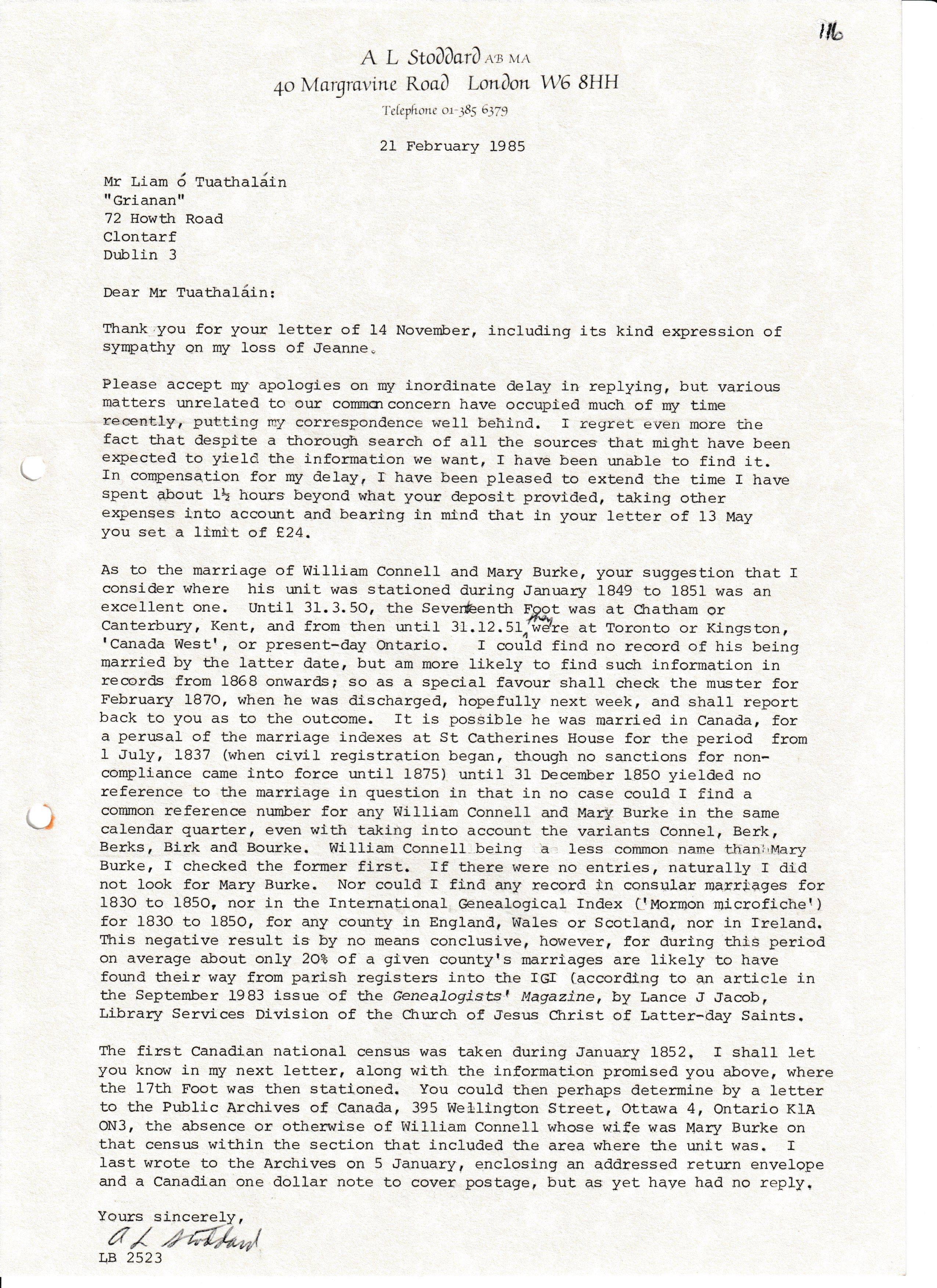
Editor's addition, 2025
The transcribed text of the original is provided here to make it better findable in an internet search.
A L Stoddard AB MA
40 Margravine Road London W6 8HH
Telephone 01-385 6379
21 February 1985
Mr Liam ó Tuathaláin
"Grianan"
72 Howth Road
Clontarf
Dublin 3
Dear Mr Tuathaláin:
Thank you for your letter of 14 November, including its kind expression of sympathy on my loss of Jeanne.
Please accept my apologies on my inordinate delay in replying, but various matters unrelated to our common concern have occupied much of my time recently, putting my correspondence well behind. I regret even more the fact that despite a thorough search of all the sources that might have been expected to yield the information we want, I have been unable to find it. In compensation for my delay, I have been pleased to extend the time I have spent about 1½ hours beyond what your deposit provided, taking other expenses into account and bearing in mind that in your letter of 13 May you set a limit of £24.
As to the marriage of William Connell and Mary Burke, your suggestion that I consider where his unit was stationed during January 1849 to 1851 was an excellent one. Until 31.3.50, the Seventeenth Foot was at Chatham or Canterbury, Kent, and from then until 31.12.514 \[they\] were at Toronto or Kingston, 'Canada West', or present-day Ontario. I could find no record of his being married by the latter date, but am more likely to find such information in records from 1868 onwards; so as a special favour shall check the muster for February 1870, when he was discharged, hopefully next week, and shall report back to you as to the outcome. It is possible he was married in Canada, for a perusal of the marriage indexes at St Catherines House for the period from 1 July, 1837 (when civil registration began, though no sanctions for non-compliance came into force until 1875) until 31 December 1850 yielded no reference to the marriage in question in that in no case could I find a common reference number for any William Connell and Mary Burke in the same calendar quarter, even with taking into account the variants Connel, Berk, Berks, Birk and Bourke. William Connell being a less common name than Mary Burke, I checked the former first. If there were no entries, naturally I did not look for Mary Burke. Nor could I find any record in consular marriages for 1830 to 1850, nor in the International Genealogical Index ('Mormon microfiche') for 1830 to 1850, for any county in England, Wales or Scotland, nor in Ireland.
This negative result is by no means conclusive, however, for during this period on average about only 20% of a given county's marriages are likely to have found their way from parish registers into the IGI (according to an article in the September 1983 issue of the Genealogists' Magazine, by Lance J Jacob, Library Services Division of the Church of Jesus Christ of Latter-day Saints.
The first Canadian national census was taken during January 1852, I shall let you know in my next letter, along with the information promised you above, where the 17th Foot was then stationed. You could then perhaps determine by a letter to the Public Archives of Canada, 395 Wellington Street, Ottawa 4, Ontario K1A ON3, the absence or otherwise of William Connell whose wife was Mary Burke on that census within the section that included the area where the unit was. I last wrote to the Archives on 5 January, enclosing an addressed return envelope and a Canadian one dollar note to cover postage, but as yet have had no reply.
Yours sincerely,
[Signature]
LB 2523
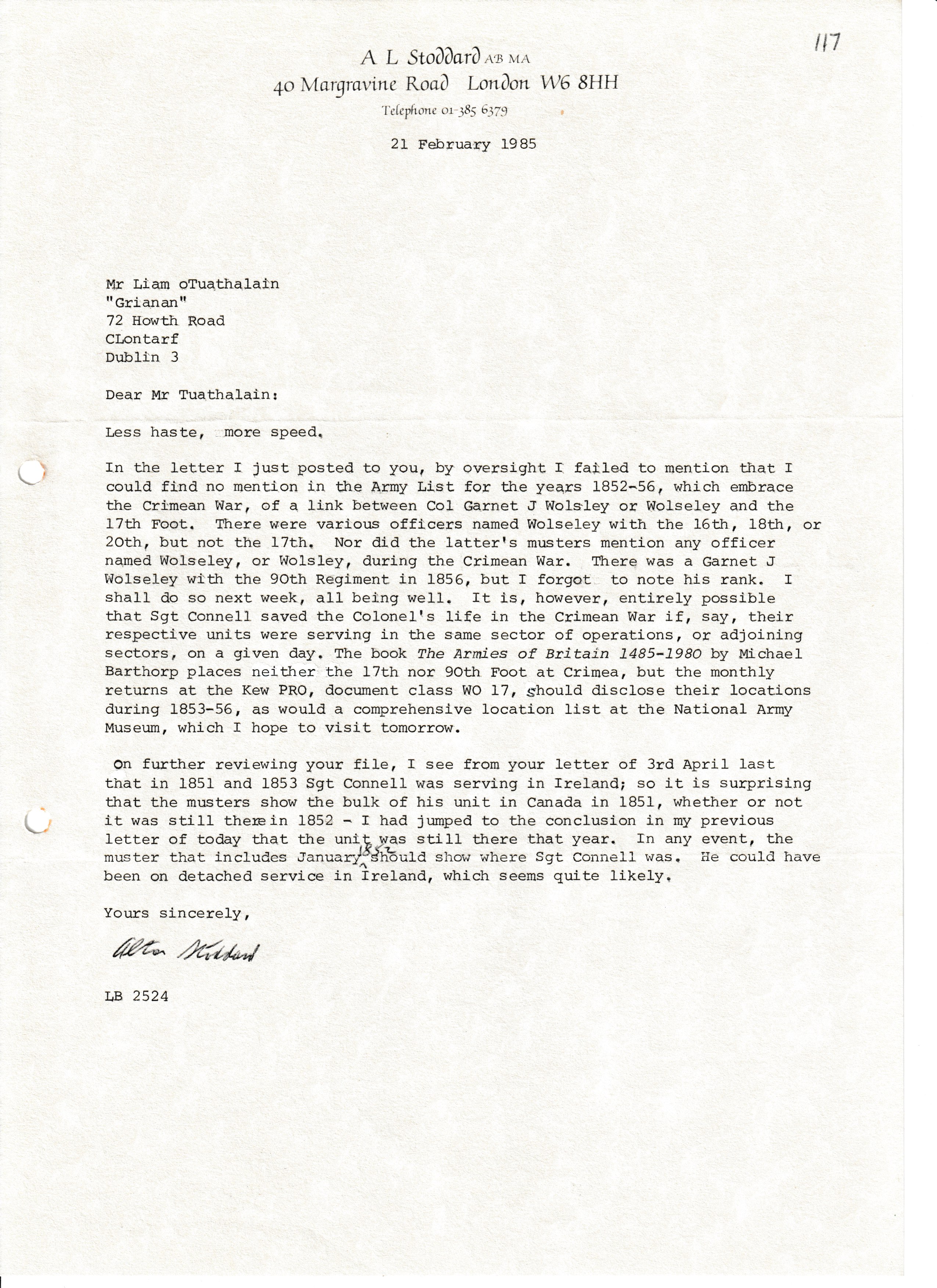
Editor's addition, 2025
The transcribed text of the original is provided here to make it better findable in an internet search.
A L Stoddard AB MA
40 Margravine Road London W6 8HH
Telephone 01-385 6379 .
21 February 1985
Mr Liam oTuathalain
"Grianan"
72 Howth Road
CLontarf
Dublin 3
Dear Mr Tuathalain:
Less haste, more speed.
In the letter I just posted to you, by oversight I failed to mention that I could find no mention in the Army List for the years 1852-56, which embrace the Crimean War, of a link between Col Garnet J Wolsley or Wolseley and the 17th Foot. There were various officers named Wolseley with the 16th, 18th, or 20th, but not the 17th, Nor did the latter's musters mention any officer named Wolseley, or Wolsley, during the Crimean War. There was a Garnet J Wolseley with the 90th Regiment in 1856, but I forget to note his rank. I shall do so next week, all being well. It is, however, entirely possible that Sgt Connell saved the Colonel's life in the Crimean War if, say, their respective units were serving in the same sector of operations, or adjoining sectors, on a given day. The book The Armies of Britain 1485-1980 by Michael Barthorp places neither the 17th nor 90th Foot at Crimea, but the monthly returns at the Kew PRO, document class WO 17, should disclose their locations during 1853-56, as would a comprehensive location list at the National Army Museum, which I hope to visit tomorrow.
On further reviewing your file, I see from your letter of 3rd April last that in 1851 and 1853 Sgt Connell was serving in Ireland; so it is surprising that the musters show the bulk of his unit in Canada in 1851, whether or not it was still therein 1852 - I had jumped to the conclusion in my previous letter of today that the unit was still there that year. In any event, the muster that includes January \[1852\] should show where Sgt Connell was. He could have been on detached service in Ireland, which seems quite likely.
Yours sincerely,
[Signature]
LB 2524
Public Record Office, London. Reference: WO 9.7 / 1444
Extracts from Discharge Papers of Sergeant William Connell, No. 2793, First Battalion, 17th Regiment of Foot. Dublin, 24th January, 1870.
Foreign Service
Gibraltar, seven months.
Crimea, one year and seven months.
North America, two years and eleven months.
Character and Conduct
His conduct has been 'very good' and he was when promoted in the possession of one good conduct badge and would had he not been promoted have been now in the possession of four good conduct badges.
Is in possession of Crimean Medal and Clasp and Turkish Crimean Medal for service in the Crimea.
Received a Silver Medal without gratuity for long service and good conduct for year 1867-68.
Has been twice entered in the Regimental Defaulters' Book and once tried by Court Martial.
Conduct 'very good' and had he not been a sergeant would have been in possession of four good conduct badges.
Reason for Discharge
His discharge is proposed in consequence of completing service qualifying for pension while serving as a supernumerary with the Dublin County Militia.
Personal details
Sgt. Connell, by trade a labourer, was born in the parish of Windgap near the town of Carrick-on-Suir in the County of Kilkenny and attested for the 17th Battalion at Clonmel in the County of Tipperary on the 18th January, 1849 at the age of 18 years.
His final description when discharged from the Service at Dublin on the 8th February, 1870 was as follows:
| Age: | 39 years. |
| Height: | 5 feet, 10 inches. |
| Complexion: | Fresh. |
| Eyes: | Grey. |
| Hair: | Grey. |
| Trade: | Labourer. |
| Scars: | No scars or marks on the face or other parts of his body. |
| Intended place of residence: | Dublin. |
Service Details
| Private | 18-1-1849 to 9-5-1854 |
| Entitled to 1 good conduct badge and pay 18-1-1854 | |
| Corporal | 10-5-1854 to 5-12-1854 |
| Sergeant | 6-12-1854 to 31-3-1857 |
| Total service allowed to reckon to William Connell to 31st March, 1857. Signed: N. Yonge, Major, Limerick Depot Battalion. | |
| Sergeant | 1-4-1857 to 27-6-1859 |
| Re-engaged at Limerick for 11 years. | |
| Sergeant | 28-6-1859 to 3-8-1859 |
| Sergeant | 4-8-1859 to 20-2-1864 |
| In confinement for drunkenness and striking a private 4 days. Tried, reduced and restored to rank of Sergeant 25-2-1864 | |
| Sergeant | 26-2-1864 to 11-1-1867 |
| Colour Sergeant | 12-1-1867 to 31-5-1869 |
| Sergeant | 1-6-1869 to 28-11-1869 |
| Transferred from 17th Foot to Dublin Militia. | |
| Sergeant | 29-11-1869 to 21-1- 1870 |
| Further service from 22nd January to 8th February when finally discharged. | |
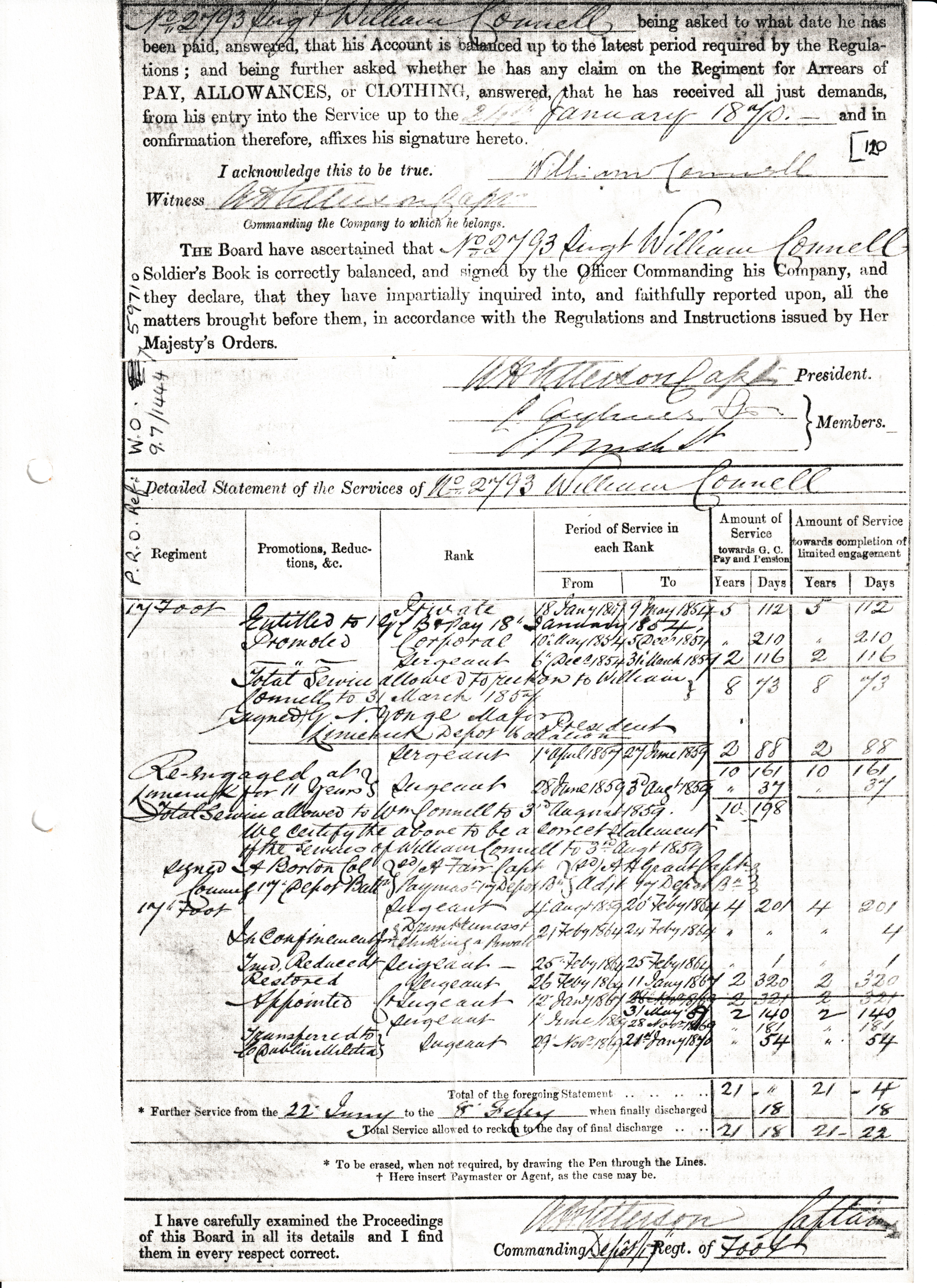
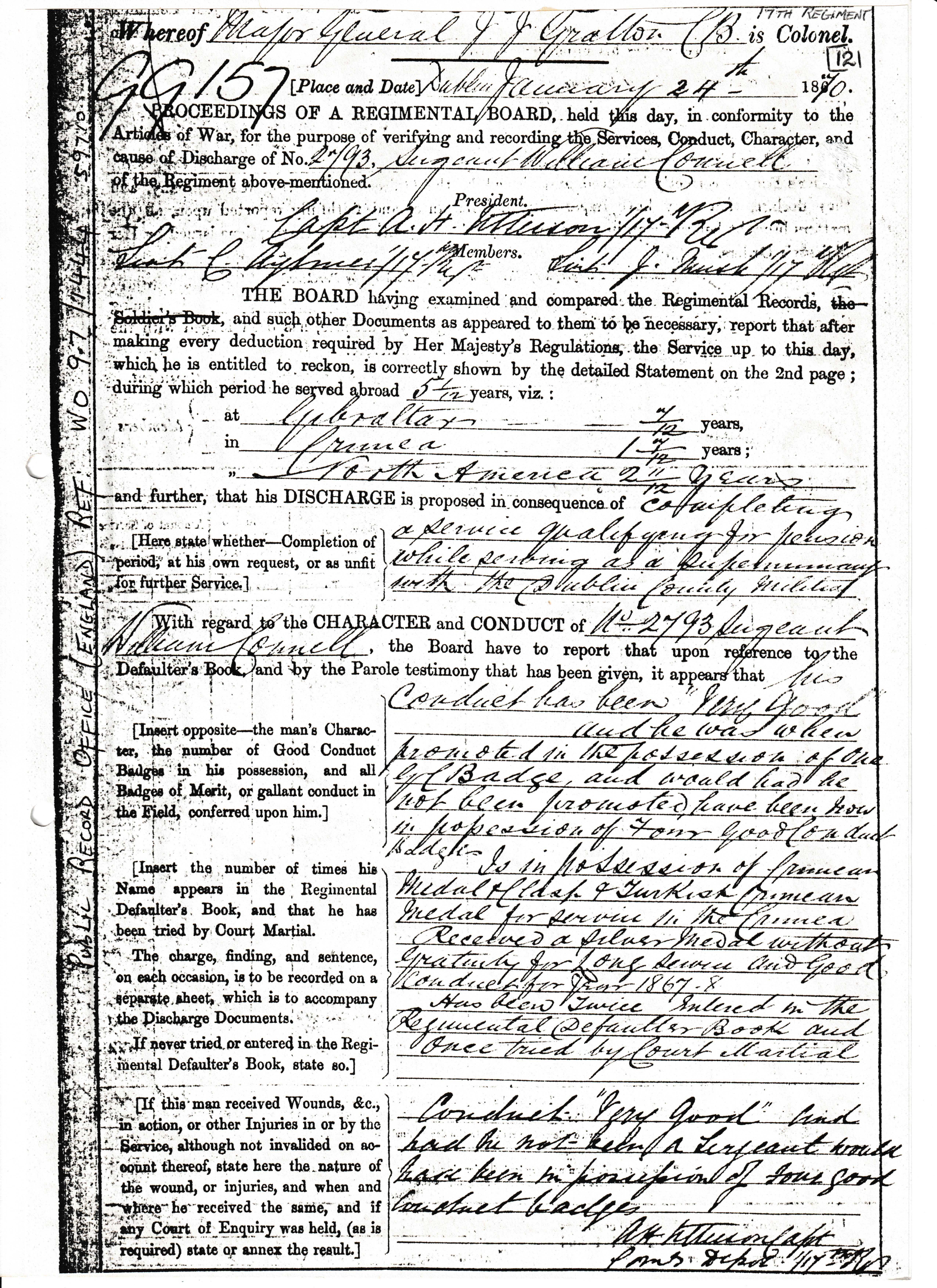
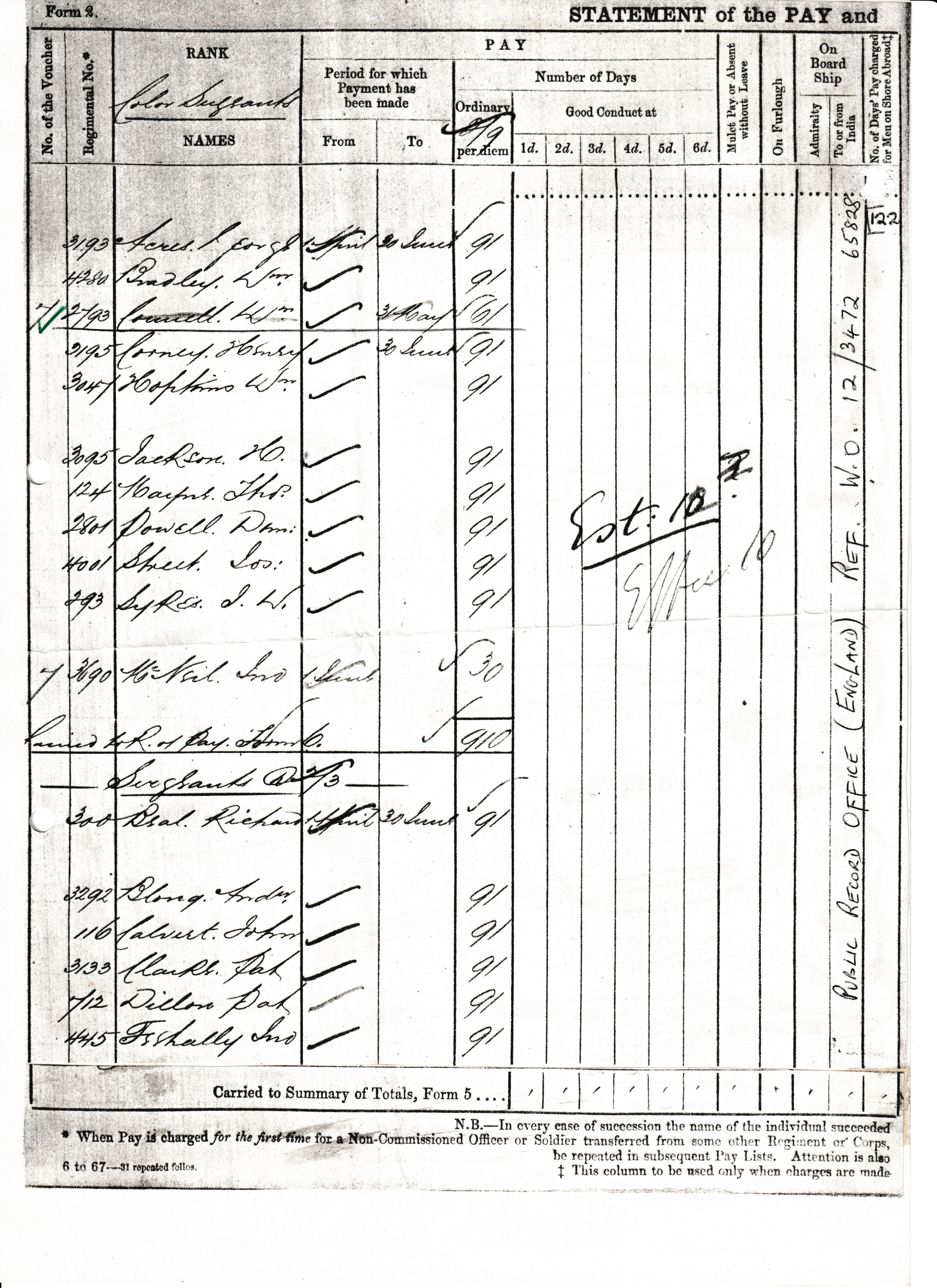
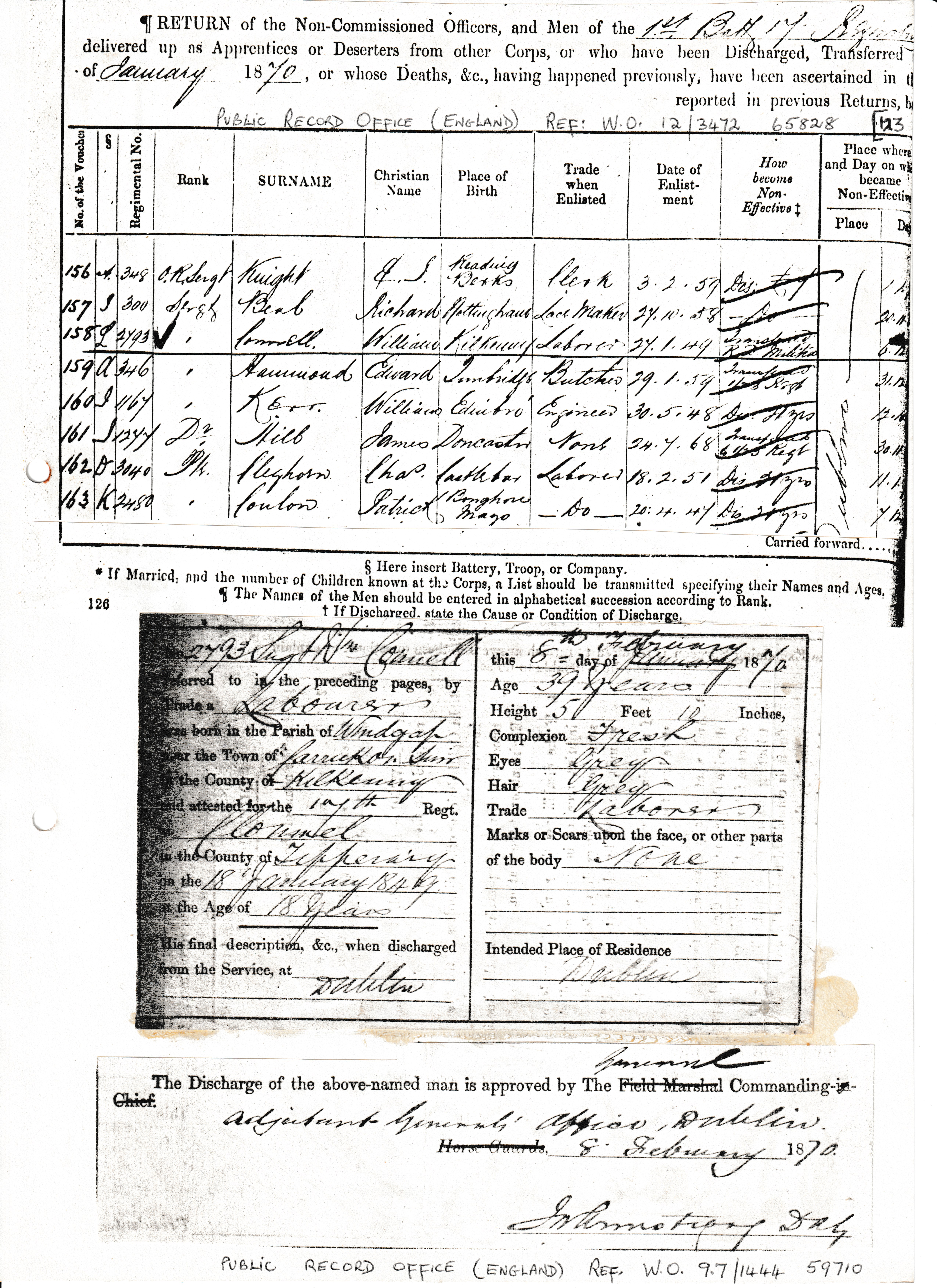
The Fenian Invasion of Canada, 1866
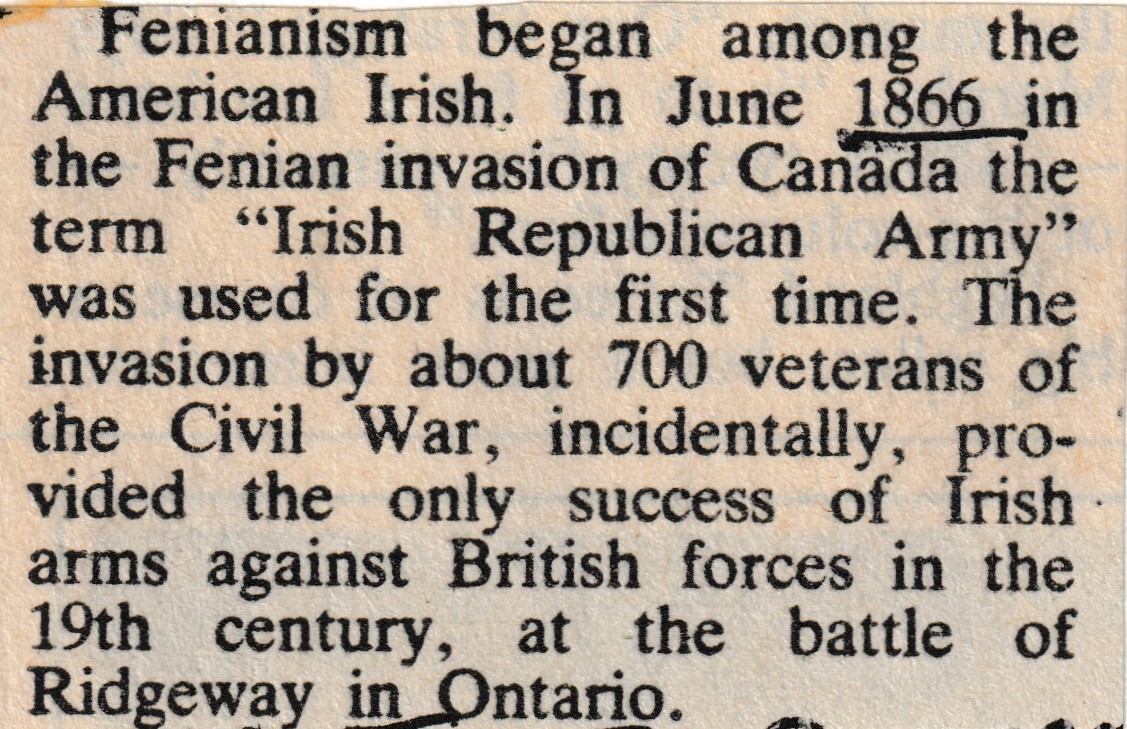
Sergeant William Connell spent nearly three years of his military service in "North America" (Canada). It is possible that he was there in 1866.
